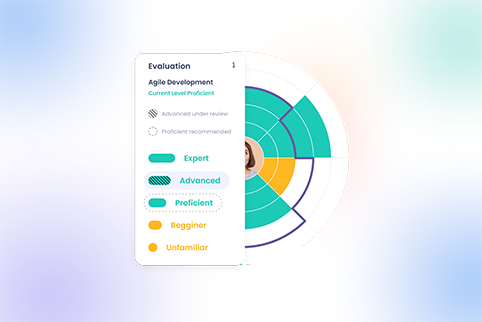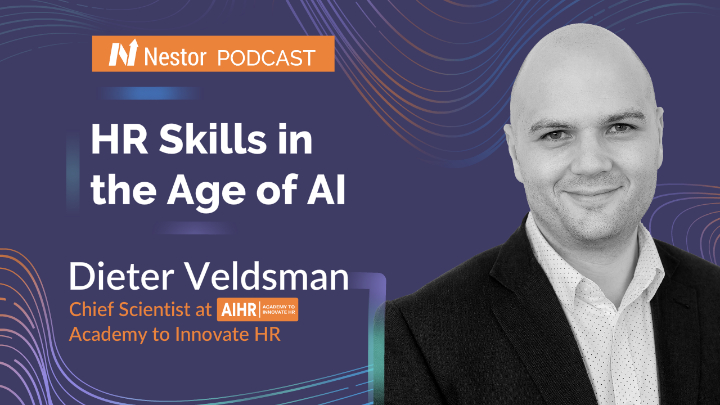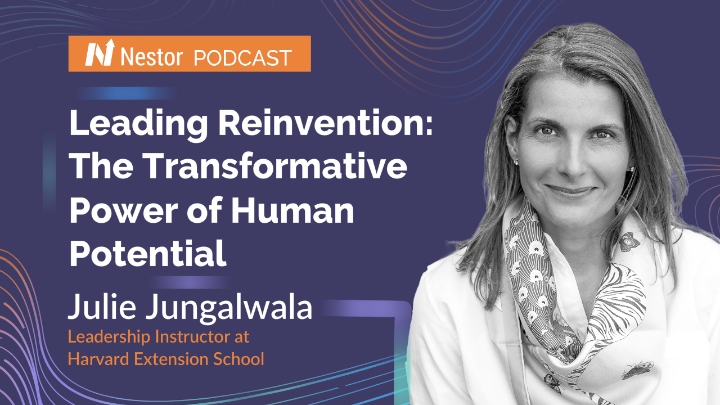Teresa Rose, an award-winning learning and performance consultant, joined us for a conversation on a very hot topic — the secrets behind successful skills transformations, pinpointing specific examples about where to start when looking to adopt skills strategies, how AI can help, what skills validations can be most reliable and how the skills ecosystem works.
Teresa has over 16 years of experience in organizational and people development, having worked with important organizations across various industries, including the World Bank Group, Deutsche Bank, Dixo, and the University of Cambridge. She is also an executive and business coach and a chartered member of the CIPD.
Teresa is the founder of ConsultHer Ltd., an organization that works across HR, Talent, DEI, and L&D to advise and help companies realize their people development strategy and goals. She is also a founding member of Digital Women and a regular chair at the Learning Technologies Conference. You can connect with Teresa on LinkedIn.
Raluca Apostol, the host of the podcast is the Chief Product Officer at Nestor and you can connect with her on LinkedIn or Twitter @RaluApostol.
You are a strong promoter of skills-based approaches in the new world of work but this concept is nothing new. Can you share more with us on this topic?
Teresa Rose: I don’t know whether I’d say I’m a promoter. I think one of the first things is whether or not it’s right for your organization. So, it’s working out, is that the right direction for you to go in? Because there are different aspects that you could take from the principles of being skills-first, or skills-powered, or skills-based, whichever one you aspire to be.
And it does have a lot of history going back to competencies, and there have been lots and lots of challenges. I’ve been on the receiving end of competency models and also worked in organizations where we’ve implemented them and people think: “Oh, what’s the difference between skills and competencies?”
And one of the main differences I think we now have is that we’ve got AI and technology to help scale and keep that up-to-date. And there is then an aspect of data because we’ve now got the data analytics and combining those two at the heart of your organizational processes — it gives you a golden thread throughout the organization, as you start to build that, and provides you with data and data-driven decision-making that wasn’t there before.
So, that’s one of the key differences, though I have done a lot of research on the approach, and I’ve found research dating back to the early 90s that skills-based organizations existed even then, and they used the best of HR practices, those practices that are deemed better for high performance, and high performing organizations, and in organizations as well like consultancy services, where skills are important.
So, it’s not anything that’s necessarily new. It’s probably more about the way that we go about it, and what we can do with the technologies that we now have at our disposal.
Research data shows that only 20% of the companies are currently adopting some sort of skills-based solutions. Do you think this is a problem? Or that some organizations aren’t ready?
Teresa Rose: A mixture. I’m always wary of surveys and that data, though it can be informative. It’s really about looking at your own context. It might not work in certain sectors. It might not work in parts of your organization. It may be useful in some certain aspects.
So, it might even mean that you take a very segmented and targeted approach to where you do use data and skills, and you might have quite a mobile workforce — and it could be in tech, in those areas of your organization where you need more fluidity of your people, and how you move them around, and also the projects that you have in.
You think about Unilever often held up as one of the great case studies, but they’re quite an unusual organization, they’re FMCG — that setup works really well for them, but it might not work for another organization, a completely different sector, or even an organization in that sector and different context.
Based on your experience working with enterprise-level organizations to implement these kinds of strategies, what are some of the challenges they face?
Teresa Rose: One of the main challenges is actually knowing where to start. How broad do you take it? So, identifying use cases and gathering your data and having evidence that there is a need there rather than suddenly saying: “Oh, we need to find out what our skills dash is because this organization is doing it and that organization is doing it.”
You might have all that data at your disposal. It might be how you’re managing it. I think another one of the challenges is starting to look at the technology landscape, and all of the different skill frameworks, because every vendor is coming out with a different approach, different skill levels, proficiency levels, proficiency descriptions. Then, you also have professional bodies and open-source frameworks that are out there.
So, it becomes quite a complex market landscape, and it gets even more complicated. And with what different research organizations come out with as well, there is so much to digest around the topic. So, it does become very complicated and complex.
And, yes, starting small and doing some tests and learns is really critical and creating your own evidence, but on something that is a use case that is going to help all parts of your organization.
I often find that organizations focus too much on the benefits to the organization and potentially talent departments and management as opposed to what are the benefits for the employees, because ultimately they're the ones that are going to be using the system.
— Teresa Rose

It also always surprises me that end users aren’t involved. I get involved in projects at different stages. If I’m in the very early stage, I also always ensure that research is done with the end users, because you need to establish:
- what their challenges are
- what frictions are there for them
- mapping out things like their current workflows
- and using things like a surface blueprint and establishing where the new process might work
And often another challenge I find that I have is not really working out the costs and time involved in this because it is a very lengthy, long process. And you’re looking at years, not months.
What advice would you give in terms of beginning to collect skills data and insights? How, when, and where to start from?
Teresa Rose: It might be something like areas where you’ve got problems recruiting, whether that’s particularly externally, and where you might be able to start building those skills internally. So, starting to cost out things like attrition as well — if you’re losing people, what’s the reason for that?
Often people are leaving because they’re not getting the career development. And we might spend quite a lot of effort and time and money on recruiting people externally when you could retrain people or as they say, reskill or upskill people internally to do, to fulfill those roles.
So, if you don’t know who’s got what skill, you can’t make those build-by, or even now as well, AI decisions around workforce planning. That tends to be one of the key areas, because if you don’t know that data, how can you plan for the work that you’ve got coming up and where are those capability gaps?
But it might also be looking at, I mean, the Singapore government is a really good case study to look at, and their country-wide skill frameworks and what they’re doing there. So, there are some really good cases and also the work that’s come out from the World Economic Forum — that report that’s come out on those Lighthouse case studies, because they’re across different sectors, which is nice to see, they’re not just large corporates.
There are government bodies, public bodies, and smaller organizations, so you can see some of the things that they’ve done and how they’ve established why that area was important to focus on and using some of that, gathering your internal data and really finding out from your stakeholders, from your employees, where the pain points are for them, and solving them, and doing something like scoring them as well — working on the use cases and deciding which use cases are going to have the biggest impact.
What do you think about skills inference and leveraging AI technology to simplify this process? What’s your take on this?
Teresa Rose: Yeah, there’s lots of benefits, but there’s also knowing and having the human oversight as well alongside the AI.
I really do like systems where the end user and the manager and a subject matter expert can go in and check and verify and validate those skills that have been allocated. And also where you’ve got very specific skills, because I like to segment skills and look at, well, what can you take from what the AI infers and can you then add in your own content but not too much of it?
So, it’s a balance because it’s keeping that up-to-date. But if you’ve got very specific skills to your organization, you’re not going to engage the end user if those skills don’t relate to the work that they do. It’s a balance between what you have from the AI, because there’s a lot of generic skills that are gonna be there — there tend to be more so in some technical areas, but more so in the behavioral or capabilities that people need, like whether that’s influencing or breaking down different communication skills.
It’s having a balance between the two. But what it does do is help you to keep it up-to-date. And that’s where governance also comes into play as well. I’ve written recently about having like a skills-sensing network in your organization. So, going back to what I said earlier about using external data, your internal data, and what’s going on in your business sector to look at:
- how often do we really need to keep any of our custom content updated?
- who reviews it and when do we review it?
- what information are we using and keeping track of so that you’re doing the best of both?
When we look at mapping skills across job roles and creating skills profiles for employees, we may tend to add so many skills to one person. Which are the skills we should prioritize first?
Teresa Rose: Yeah, it might be that you’re doing some work with a stakeholder and you identify priority skills for certain roles, and you don’t really overload people so that they can be focused on what’s most important to their role and what you need to do as an organization or a department.
And that then is going to narrow that down. But I’d say you don’t want to really put anything more than like 15-20 skills on someone’s profile. They might be able to add more themselves. It’s really important that the employee has control over their profile and they can add more skills that might be, you know, from their history.
But people are more than skills. So, if you can add more data beyond skills as well, projects, work that people have done, and their interests, and things like that — it's looking at a person much more holistically. People are far, far, far more than a list of skills.
— Teresa Rose

Adding skills to an employee profile is one thing. But what about validating those skills?
Teresa Rose: We could spend a whole day talking about that topic, I think.
That’s again where you have to look at your HR processes, your people processes, where you might use them for decision-making, and where certain things could be more subjective, but also being open and transparent with employees about where skills are used as part of a decision process, not overall, it’s a decision-making process.
So, it is using different assessment methodologies. And also there’s a difference, for me, between validation and assessment of skills, and gathering that data and that evidence in different ways. It might be that you can’t do it all in one system or all in one method.
And then you’ve got mixed methods, either in assessment centers before, and there tends to be a whole day when you’re making really higher-level decisions on executive appointments and things like that. You’re going to be looking at a lot more data sets than purely a skills assessment.
And it’s a self-assessment on a lot of these systems, and they in themselves are quite dangerous. You can’t really make any decisions on a self-assessment because we often don’t know what we don’t know. And you’ve got a lot of biases in there, like Dunning Kruger. Some of the ways you could get over bias is that you’re going to ask several peers, a bit like 360-degree feedback, and your manager and you start to aggregate that data and that starts to remove some of that bias.
But it’s a mix as well, you don’t want just the quantitative data — what qualitative information and evidence have you got that people have been able to use that skill as knowledge and do something with it? You could just gather lots of skills, but what are you actually doing with that skill to impart the knowledge and create some form of value?
There’s great value in identifying skill gaps and upskilling needs. How important is an LMS in that direction? And what about the connection between an LMS and a platform that matches skill gaps with development opportunities?
Teresa Rose: For me, the most important part is where you can start to learn through the work that you do, as opposed to necessarily going and getting lots of content and learning pathways from the learning management system. They don’t have a significant impact in upskilling unless I can actually apply that in the workplace. And that is also a danger. I’ve written about that as well with future skills.
Because you get lots of lists this time of year of “these are all of the future skills“. But if we spend time developing people — and I’ve seen this in an organization I worked in a couple of years ago, a big campaign around future skills and giving everyone access to these different pathways, which they’re then not going to use, because:
- they’re not relevant and they’re a poor investment
- there are challenges on learning and development budgets
- and there are challenges in showing impact and value
It’s really important to think very carefully about what you do put in place for development, and if you’re starting to build up the skills and the data, and you want to then use a talent marketplace — that’s one way where you could put stretch assignments on there and things in the work that people can do, alongside a content strategy.
And that’s really important as well because often people will go through a proficiency assessment and they’ll do that self-assessment that we’ve just touched on, and they’ll get recommended content, but that content isn’t necessarily helping them move from one level to another. And it’s also important that it takes time. It takes time to improve your proficiency and that’s through practice. So it’s anything that can give you an opportunity to practice.
Another important point is developing that skill in isolation, because your skills are interoperable. They are what create you and how you go about your work. It's important that you don't focus on one skill at a detriment to another. And think about how those skills might be combined in the work that you do.
— Teresa Rose

Raluca Apostol: Yes, and to get even more value by combining all the skills that you have. So, the take here is we don’t have to think only on the content side…
Teresa Rose: No, not at all.
Raluca Apostol: …but we need to practice the knowledge we gain. So, maybe projects or shadowing someone, or practicing something, or learning and doing something, something afterward — this would be really helpful to upskill efficiently.
Teresa Rose: And now we have AI as well. We can individually use AI as a way to learn and use it as our own personal tutor as well.
What else should organizations consider to integrate a complete skills tech ecosystem into their strategy?
Teresa Rose: I think it’s really looking and auditing your current systems, because you might find that you’ve got some functionality in a system you already have that you didn’t know about. That would be a starting point if you’re wanting to look at skills tech before deciding to go out and get a new system in place.
It’s also thinking about if you’re looking at a new system, your overall HR tech strategy then, because it might be that you don’t need some of the tech you’ve got, you might be able to get a system in that replaces some of that — and that’s again another long-term plan and strategy, and it’s involving those partners in that.
This is very collaborative to work, it's not got to be one area of HR that's leading, it can't just be L&D, particularly if it's a larger organization. It has to be an organization-wide project, particularly involving your IT partners. They're so important to this. Your data scientists are so important to this.
— Teresa Rose

And, of course, your end users, which often get forgotten. So, I’m gonna remind what I said earlier on, that this is so important and it just doesn’t really happen enough. It just makes such a difference to co-create, if we’re going to use some buzzwords, with the people that you want to use it.
For more information on skills-based approaches, read also Teresa Rose’s paperwork on Learning GUILD:







